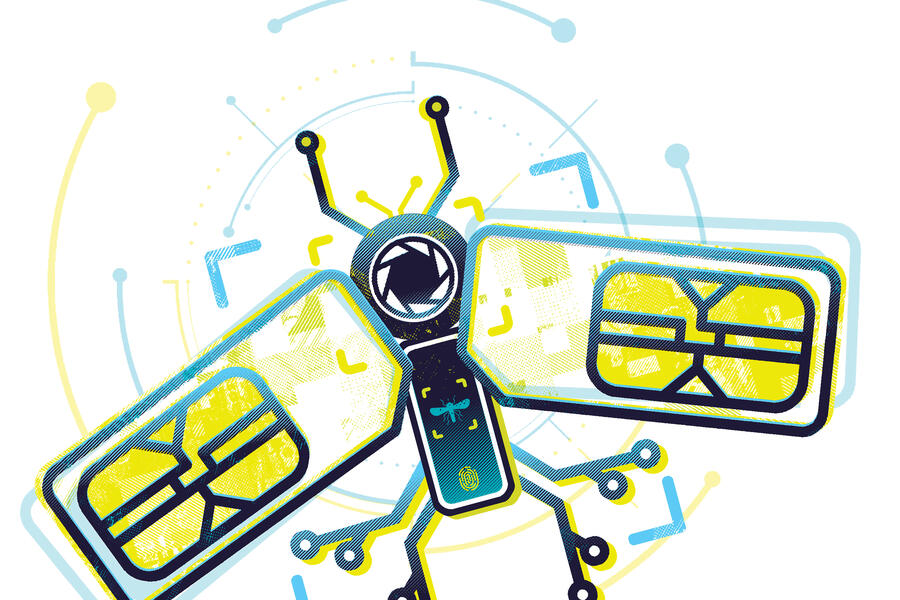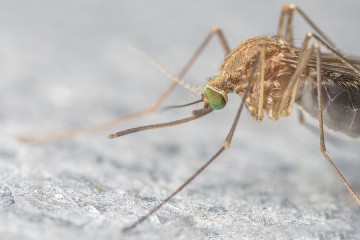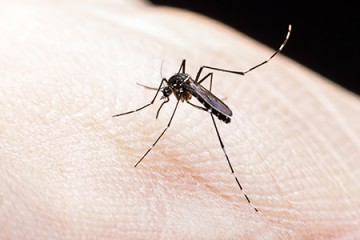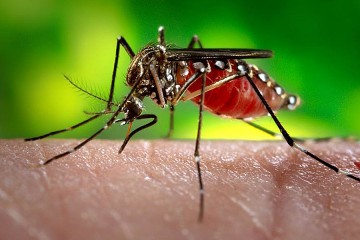In an evolutionary paradox, one of the world's most ancient predators might meet its match in one of humankind's most modern advances: mosquito vs. artificial intelligence.
Mosquito identification and tracking have long aided public health efforts to prevent and treat mosquito-spread diseases, such as malaria, dengue, yellow fever, or West Nile virus.
But various factors can make identification difficult. Mosquito wings and legs can break during trapping, and sizes can vary even within the same species. Even more challenging: There's a worldwide shortage of trained entomologists, especially in Africa. In many cases, months can pass between mosquito collection and regional decisions about vector control efforts tailored to a specific species.
Through AI-powered smartphone apps, algorithms, machine learning, and image databases, Hopkins researchers and alumni are leveraging AI to rapidly identify mosquitoes and share data to enhance lifesaving public health efforts.
Key Takeaways
- Mosquito identification and tracking is essential to controlling the spread of diseases such as malaria
- One challenge is a worldwide shortage of entomologists
- Technology originating in the Johns Hopkins Center for Bioengineering Innovation & Design uses AI to rapidly identify mosquitoes
Research originating in the Johns Hopkins Center for Bioengineering Innovation & Design has fostered two AI mosquito identification tools. VectorCam is an open-source smartphone-based app and hand-held scanner shown to aid public health workers in rural Uganda. And Vectech, a startup company partnering with nearly 80 public health organizations globally, offers a digital microscope integrated with AI trained on a vast image database.
Health workers could free up entomologists to plan wider interventions and could assist with identification using AI tools if no entomologist is available, researchers say. In November, VectorCam co-founder Sunny Patel presented at the American Society of Tropical Medicine & Hygiene's annual meeting on the low-cost AI mosquito identification tool researchers say could empower nonexperts and help expand malaria control. "We wanted to make it very user-friendly," Patel, A&S '22, Engr '24 (MSE), told the audience.
Fighting malaria is particularly daunting, with an estimated 263 million cases and 597,000 malaria deaths worldwide in 2023, according to WHO's latest World Malaria Report. Children under age 5 are among those at highest risk.
Faster mosquito identification and data collection are increasingly relevant, with rising insecticide resistance and climate change allowing mosquitoes to spread to formerly cooler climes. Among other challenges: Hotter dry seasons in regions of Africa have caused heavy thunderstorms, fueling unexpected mosquito surges.
Soumyadipta Acharya, CBID's graduate program director and a Johns Hopkins assistant professor of biomedical engineering, was the principal investigator during both tools' research phases at CBID. Acharya is currently partnering with VectorCam researchers, including co-founding a nonprofit, with plans to expand across Uganda and into other African nations: "There are multiple levels of transformation this could catalyze," Acharya says.
Faster identification could speed up such interventions as providing bed nets or spraying insecticide. Rapid data sharing across regions could allow health officers to track mosquitoes' changing behaviors, Acharya and other researchers say. For example, malaria-spreading Anopheles mosquitoes have tended to lay eggs in rural marshes or near streams. But a highly adaptable invasive species, Anopheles stephensi, has been discovered in Africa's expanding urban areas, adept at breeding amid man-made materials too: leaking pipes, AC units, or cement cracks, research shows. Patel says the questions become: "How can we rapidly find it? How can we rapidly identify it?"
A few basics for AI-enabled identification: Researchers have built algorithms, trained on tens of thousands of mosquito images, to recognize the scanned samples.
With VectorCam, for example, a slide of a mosquito is placed in a tray, then slid into a hand-held device plugged into a smartphone; an LED light illuminates the magnified sample. "The device itself draws power from the phone," Acharya says. A mobile app contains a "neural network," the backbone of deep learning algorithms, to identify mosquito species. "As soon as the picture is taken, the trained neural network, which you can think of as the virtual entomologist, is immediately looking." The device works with inexpensive smartphones in areas without internet access.
In a 12-month randomized controlled trial concluded in August, the researchers, consulting with local experts, enrolled 240 households in Uganda and 48 community health workers. After minimal training, health workers used the tool to identify more than 70,000 mosquitoes. VectorCam matched and often exceeded routine entomologist methods for identification in time-per-mosquito and accuracy, and it was "far superior" in data completeness speed, Patel says.
Vectech, meanwhile, assists varied public health vector surveillance programs. "Slides of mosquitoes, ticks, and other suspect disease- carrying insect samples are scanned by an optics device which captures unique visual characteristics that distinguish one species of insect from another," notes Tristan Ford, Vectech co-founder and CEO. Company AI algorithms, trained on the image database using neural networks, can automatically identify species and sex; count specimens; and report digital results for more than 55 mosquito species and 30 tick species," says Ford, Engr '19 (MSE), who notes the system can identify samples with over 95% accuracy and is expanding to blackflies, sandflies, and biting midges.
That approach can be especially helpful in the United States, where, despite successful public health efforts that have mostly eliminated such diseases as malaria, a shortage of entomologists remains, especially in rural areas, says Ford, who launched Vectech with fellow CBID graduates in 2020.
With these AI tools, if a mosquito species buzzing around certain neighborhoods carries West Nile virus, and sample mosquitoes test positive, health officials could rapidly deploy interventions tailored to that species, such as placing larvicides in storm drains or issuing public warnings to use insect repellent. "You know that neighborhood is at really high risk, that West Nile virus could be actively being transmitted in that community," Ford says, "so you'll respond quickly."
Posted in Science+Technology
Tagged malaria, artificial intelligence, dengue virus, mosquitoes











